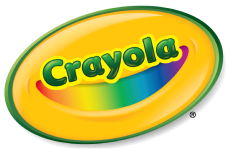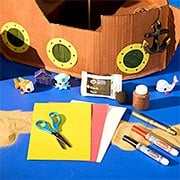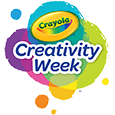L'arte può essere disordinata, quindi i nostri esperti hanno creato suggerimenti professionali per aiutarti. Visita Crayola.com per trovare soluzioni di rimozione delle macchie per i prodotti Crayola su una varietà di superfici.
If you have additional questions, we would love to hear from you! Feel free to call or text us at 1-800-CRAYOLA weekdays between 9 AM and 4 PM Eastern Time. If you would prefer to send us an email, visit our contact us page.
Domande Correlate
Esplora le risposte alle domande più frequenti, consigli utili per rimuovere le macchie e tante idee creative per sfruttare al meglio i nostri materiali artistici e le risorse gratuite.
-
Crayola Sidewalk Chalk is a molded chalk made of Plaster of Paris and color pigments. Although it is designed to be used on sidewalks and driveways, the chalk contains colorants, which may stain clothing and other household surfaces. If the chalk is used on a newly poured sidewalk or driveway, there is a possibility that the open surface pores in the concrete could absorb the colors.
We suggest testing Crayola Sidewalk Chalk in an inconspicuous area and then washing it away with water. In most cases, chalk markings wash away with the first rainfall if used on a paved or poured surface that is more than two years old.
Crayola offers stain removal suggestions as a service to consumers. You can find this information on the Crayola Stain Removal Tips page.
Please bear in mind that while all stain removal suggestions have been tested in our laboratory, results are not guaranteed. We recommend testing any suggestion in an inconspicuous area first.
If you have additional questions, we would love to hear from you! Feel free to call or text us at 1-800-272-9652 weekdays between 9 AM and 4 PM Eastern Time. If you prefer to send us an email, please visit the Crayola Contact Us page.
-
Crayola® did not invent the crayon. The "modern" crayon originated in Europe, initially made from a mixture of charcoal and oil, later replaced by powdered pigments. Wax was later substituted for oil, making the sticks sturdier and easier to handle.
In 1902, Crayola Crayons were invented by Binney & Smith and first offered for sale in 1903. The trade name "Crayola" was coined by Mrs. Edwin Binney, combining "craie" (French for chalk stick) and "oleaginous" (oily).
Crayola manufactures over 3 billion crayons each year, primarily made from paraffin wax and color pigment. Learn more about Crayola's colorful history at Crayola.com.
-
Color Wonder is a patented mess-free creative system of inks and paints, developed by Crayola scientists.
Is Color Wonder Safe?
- Just like all Crayola products, Color Wonder is nontoxic.
What makes Color Wonder different from Washable Markers and Paints?
- Color Wonder inks and paints are clear, and colors appear only on special Color Wonder paper. Kids love to watch the colors magically appear, and parents love the fact that Color Wonder inks and paints will not appear on skin, walls, or carpet.
What Color Wonder products are available?
- There are so many ways to create with Color Wonder! With Color Wonder markers, paints, and stampers the possibilities are endless. Learn more about the Crayola Color Wonder line.
Can I reuse my Color Wonder Paper?
- You cannot reuse the same piece of Color Wonder paper twice.
-
We value your commitment to recycling products you are no longer using.
At Crayola, our primary focus is on providing safe, high-quality products. To maintain the standards of safety and performance that our customers expect, we carefully select and screen raw materials for our crayons. Unfortunately, introducing recycled crayon wax into our manufacturing process would compromise these standards.
Crayola is committed to sustainability and environmental responsibility. To learn more about our efforts to support a greener planet, please visit our Sustainability Page.
-
As we deepen our commitment to sustainability, we're researching what programs will make the most significant impact and help us advance our sustainability goals, like our commitment to significantly reduce emissions from our business operations by 2030.
We have already taken several steps to make our products and operations more sustainable by focusing our efforts on renewable energy and packaging initiatives.
- Renewable Energy: The 20-acre solar farm on our Crayola campus in Pennsylvania provides the electricity to make 1 billion crayons, 700 million markers a year, and 120 million jars of paint.
- Plastics Reduction: In the last 10 years, we've redesigned our broad line markers to save an estimated 2 million pounds of plastic versus its previous design.
- Packaging: We make our marker Classpack packaging with 100% recycled cardboard. Starting in 2023, this packaging, along with crayon sleeves, will be made with natural cardboard instead of bleached cardboard, which will reduce C02e emissions by an estimated 100 metric tons per year.
- Carbon Footprint: Crayola, through our parent company Hallmark, joined the Science Based Target initiative, a collaboration of global nonprofit organizations, businesses, and world governments that set goals to limit global warming to not exceed 1.5°C. To achieve this, participating organizations will need to reduce carbon emissions significantly by 2030. Crayola sources raw materials locally and manufactures many crayons and markers close to where they are used, which helps reduce the carbon footprint. In fact, Crayola has reduced CO2e emissions from our company-owned facilities' direct and indirect energy sources by 82% since 2019, with investments in renewable energy, as well as efficiencies in our US manufacturing process. (Direct energy includes the gasoline, oil, natural gas, etc. used while indirect emissions are created when the energy is produced but not where it is used.)
- Reforestation: Most Crayola colored pencils are made from wood that is reforested in an 8,288 hectare pine farm in Brazil. Each year 300,000 seedlings are planted to restore the forest.
For more information on Crayola sustainability efforts, check Crayola's Sustainability Page.



